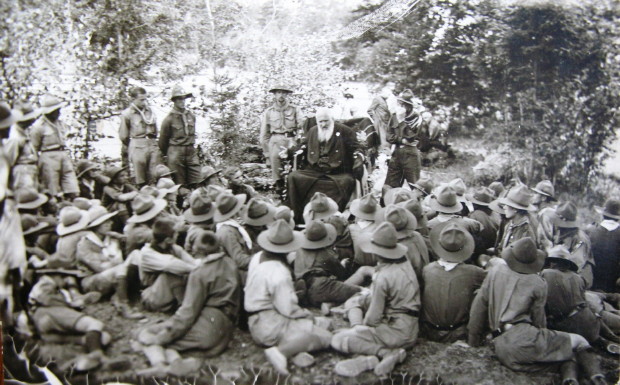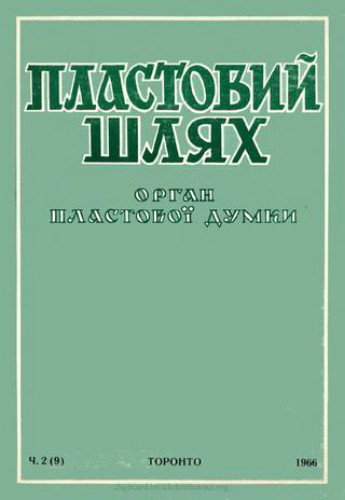Plast Ukrainian Youth Association
Plast Ukrainian Youth Association (Пласт, Організація української молоді; Plast, Orhanizatsiia ukrainskoi molodi). A Ukrainian scouting organization, based on general Scout principles that have been adapted to the needs and interests of Ukrainian young people. Its main goals include nurturing skills (particularly camping and outdoor activities), developing moral character and leadership qualities, and fostering a sense of Ukrainian patriotism among its members. The organizational name Plast is derived from the Ukrainian word plastun, a scout of the Zaporozhian Cossacks.
History to 1945. Ukrainian scouting organizations emerged almost simultaneously in both the Russian Empire and the Austro-Hungarian Empire not long after Lord Baden-Powell introduced the scouting concept to the world in 1907. After the struggle for independence (1917–20), however, they survived only in Western Ukraine. In the Ukrainian SSR scouting was suppressed and replaced by the Pioneer Organization of Ukraine and the Komsomol.
The driving force behind scouting in Western Ukraine was Oleksander Tysovsky, the founder of Plast. In 1911 he formed an extracurricular scouting group at the Academic Gymnasium of Lviv, where he was a teacher. Similar groups were formed concurrently by Petro Franko and Ivan Chmola. The Plast scouting movement spread quickly to other cities and towns. By 1913 an organizational framework had begun to evolve, and two organizational handbooks had been published, Tysovsky’s Plast and Franko’s Plastovi hry i zabavy (Plast Games and Activities). With the outbreak of the First World War Plast activities decreased considerably, as many older members volunteered for military duty with the Ukrainian Sich Riflemen and later the Ukrainian Galician Army. In 1915 a girls’ Plast organization arose.
Scouting groups emerged in Russian-controlled Ukraine as early as 1909 and included up to 50,000 adherents by 1917. The activity was initially unstructured, but it started to organize according to the Baden-Powell model with an institutional base when officials of the Kyiv educational district, led by a Russian, A. Anokhin, began promoting scouting as an extracurricular program. Specifically Ukrainian scouting troops were first formed in 1917, when Yevhen Slabchenko organized a scouting troop in Bila Tserkva. Similar groups were formed shortly thereafter in Kaniv, Kyiv, Katerynoslav, Vinnytsia, and other locations. After the establishment of Soviet rule in Ukraine, these groups were disbanded. In some locations (Kyiv, Odesa, Chernihiv) former scout leaders re-established their troops nominally as ‘young Communist’ scout groups, but these were judged by the authorities to be apolitical and were disbanded. The socializing of young people carried out by scouting was eventually taken over by the Pioneer Organization of Ukraine.
After the First World War Plast entered its most active phase in Western Ukraine. For a short period (1918–20) Plast activities were carried out under the auspices of the legally sanctioned Ukrainian National Society for Child and Adolescent Care. By 1920–1 Plast had resumed operations under its own name. It soon developed a network of groups affiliated with secondary schools in Galicia and with Prosvita societies in Volhynia. A highly successful Plast movement was started in Transcarpathia in 1921, but it remained independent of the Plast mainstream (it published a scouting journal Plastun). The organization’s core group, Ulad plastovoho yunatstva, or UPYu, for 12- to 18-year-olds (equivalent to Scouts and Guides), was supplemented with Ulad plastovoho novatstva, or UPN, for 7- to 12-year-olds (equivalent to Cubs and Brownies) in 1924; with Ulad starshykh plastuniv, or USP, for 18- to 30-year-olds (Rovers), in 1924–5; and with Ulad plastovykh senioriv, or UPS, for those over 30 years of age (Senior Scouts), in 1930. Organizational journals began to be published, including Molode zhyttia, which also had a general circulation. Special courses for training group leaders were organized, and an organizational handbook, Zhyttia v Plasti (Life in Plast), was prepared by Oleksander Tysovsky in 1921. Support materials for group leaders often appeared in specialty publications, such as Plastovyi shliakh, Plastovyi provid, and Ukraïns’kyi Plast. Organizers were designated to provide assistance in forming new groups. Finally, an economic co-operative was formed under the Plast name (see Co-operative movement).
Plast failed to develop in Bukovyna during the interwar period because of the suppression of Ukrainian cultural activities by the Romanian authorities. Some furtive attempts were made in the early 1930s to establish semilegal Plast groups at a number of secondary schools and gymnasiums, and individuals and clubs maintained ties with Plast in Galicia.
By 1930 Plast had developed a wide-ranging organizational structure, with over 6,000 members in 10 regional districts, and was able to sponsor diverse programs, including a series of highly successful summer camps, for young people. Even more significant, Plast was becoming a popular movement with support emerging from beyond urban educational circles and slowly developing among the working class and at the village level throughout Western Ukraine. It had developed a definite group ethos, part of which included a strong Ukrainian consciousness. Concern about Plast’s growing influence on Ukrainian young people, as well as the tendency for nationalist organizations to recruit Plast members after they left the ranks, led the Polish government to bar the organization from forming in state schools (1924), from operating in Volhynia (1928), and finally from operating altogether in Polish-controlled territory (1930). With most of its assets confiscated, its publications banned, and a number of its leading members arrested, Plast was forced underground. Throughout the 1930s it operated illegally or through other bodies, such as the Ukrainian Hygienic Society (in organizing summer camps) and the Plai hiking society, and thus managed to maintain certain aspects of its program. More routine Plast activities were continued in Transcarpathia (until it was occupied by Hungary in 1939) and in individual Central and Western European cities in which Plast units had been formed. The latter were organized into the Prague-based Union of Ukrainian Plast Emigrants, or SUPE, in 1931.
In October 1939 under German occupation, M. Ivanenko revived Plast in Sianik (Sanok), but soon thereafter the German authorities ordered the organization to disband. Still, during the Second World War Ukrainian scouting activities in Western Ukraine continued to be carried out through other agencies, the Ukrainian Youth Educational Societies. The Soviet occupation of Western Ukraine in 1944 brought an end to all Plast activity there.
Development in the West. Plast re-established itself in the West after the Second World War. The groundwork for the new wave of activity was laid in 1945–8 in the displaced persons camps of Germany. In October 1945 a gathering in Karlsfeld (near Munich) revived SUPE and developed general guidelines for conducting organizational activity in the camps. Plast attracted a membership of approximately 4,800, renewed programs, and resumed its publishing activity (Iunak, Plastovyi shliakh, Hotuis’). Subsequent gatherings in 1947 and 1948 established more formal organizational structures (specifically the Plast International Council, or HPR, and the Plast International Executive, or HPB) and guidelines for developing Plast branches (stanytsi) in the West. After the mass resettlement of Ukrainians in 1948–52, Plast branches were established in Australia, Argentina, Canada, Great Britain, Germany, and the United States. The First National Plast Conference was held in Toronto in 1949. In 1954 the first Conference of Ukrainian Plast Organizations, or KUPO (which replaced SUPE), was organized in order to elect new members to the HPR and HPB. Since that time KUPO elections have taken place every three years.
The Plast International Executive (HPB) co-ordinates the program and gives directives to Plast National Executives, which in turn direct their respective local branches. Methodological training for scouting leaders is also governed by the HPB. Training of scoutmasters for the Ulad plastovoho novatstva is organized by Orlynnyi kruh. Notable members have included Leonid Bachynsky, T. Bilostotsky, T. Samotulka, A. Horokhovych, Lesia Khraplyva, and Ye. Hoidysh. Training of leaders of the Ulad plastovoho yunatstva is carried out by Lisova shkola (for males) and Shkola bulavnykh (for females). Notable organizers of Lisova shkola have included M. Rakovsky, Yu. Kryzhanivsky, and P. Sodol. Organizers of Shkola bulavnykh have included Olha Kuzmovych, T. Boiko, and D. Horbachevska. Specialty camps have been organized by specific kurini (companies) of Ulad starshykh plastuniv (USP) and Ulad plastovykh senioriv (UPS): the kurin Pershi stezhi, for example, organizes the Stezhky kultury (Paths of Culture) camp; the Burlaky (Vagabonds) specialize in skiing and mountaineering camps; and the Chornomortsi (males) and Chornomorski khvyli (females) organize special water-sports camps. In 1991 there were 27 different kurini of USP and UPS: Kurin im. Tysovskykh, Ti shcho hrebli rvut, Lisovi chorty, Kharakternyky, Chervona kalyna, Zakarpattsi, Kurin im. A. Voinarovskoho, Kurin im. H. Orlyka, Chornomortsi, Dubova kora, Burlaky, Pershi stezhi, Chota krylatykh, Khrestonostsi, Buryverkhy, Karpatski vovky, Khmelnychenky, Chortopolokhy, Kniahyni, Verkhovynky, Siromantsi, Blyskavky, Vovkulaky, Stepovi vidmy, Braty Movgli, Shostokryli, and Pobratymy; as well as three that were still waiting for registration at that time, Spartanky, Chornomorski khvyli, and Lisovi mavky.
The titular head of the whole Plast movement is the Nachalnyi plastun (Head Scout). To date, three have been elected, Severyn Levytsky (1947–62), Yurii Starosolsky (1972–91), and Liubomyr Romankiv (1997–2016).
In 1990 Plast was legally restored in Ukraine as the Plast Ukrainian Scout Association; it is currently active in numerous cities and towns, including Kyiv, Lutsk, Lviv, Ternopil, Zhytomyr, and many others. The movement is spreading quickly throughout Ukraine. Plast has been restored also among Ukrainians in Poland and in the Prešov region of Slovakia.
Plast in the diaspora has remained active to the present day. Activities include weekly meetings of Ulad plastovoho novatstva and Ulad plastovoho yunatstva, lectures, sports events and competitions, hikes and tours, and winter and summer camps. In August 1991 Plast was still independent of the International Scouting Organization and other national scouting movements.
Yurii Starosolsky
[This article originally appeared in the Encyclopedia of Ukraine, vol. 4 (1993).]
.jpg)

.jpg)
.jpg)

.jpg)